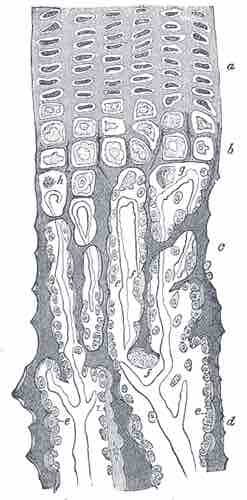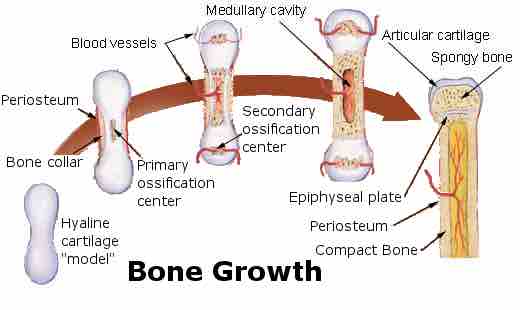Postnatal Ossification
Secondary ossification occurs after birth. It forms the epiphyses of long bones and the extremities of irregular and flat bones.
The diaphysis and both epiphyses of a long bone are separated by a growing zone of cartilage (the epiphyseal plate). When a child reaches skeletal maturity (18 to 25 years of age), all of the cartilage is replaced by bone, fusing the diaphysis and both epiphyses together (epiphyseal closure). This process involves replacing the hyaline cartilage, initially present at the epiphyseal region, with active osteoblasts that deposit bone structural proteins.
Epiphyseal plate
The epiphysis is the rounded end of a long bone located at its joint with adjacent bone(s). Between the epiphysis and diaphysis (the long midsection of the long bone) lies the metaphysis, including the epiphyseal plate (growth plate).
The Role of Osteoblasts

Developing femur
Pictured is part of a longitudinal section of a rabbit's developing femur, with parts including: a) Flattened cartilage cells; b) Enlarged cartilage cells; c), d) Newly formed bone; e) Osteoblasts; f) Giant cells or osteoclasts; g), h) Shrunken cartilage cells.
Osteoblasts are mononucleate cells that are responsible for bone formation. In essence, osteoblasts are specialized fibroblasts that, in addition to fibroblastic products, express bone sialoprotein and osteocalcin.
Osteoblasts produce a matrix of osteoid that is composed mainly of Type I collagen. Osteoblasts are also responsible for the mineralization of this matrix. Minerals required for mineralization and related processes include zinc, copper, and sodium.
Bone is a dynamic tissue that is constantly being reshaped by osteoblasts and osteoclasts. Osteoblasts produce bone matrix and mineral, and osteoclasts break down the tissue. The number of osteoblasts tends to decrease with age, affecting the balance of the formation and resorption in the bone tissue, and potentially leading to osteoporosis.
During postnatal bone formation, endochondral ossification initiates bone deposition by first generating a structural framework at the ends of long bones, within which the osteoblasts can synthesize a new bone matrix.

Endochondral ossification
The development of the primary and secondary ossification centers.
Cartilage to Bone
- Zone of reserve cartilage: This region is farthest from the marrow cavity and consists of hyaline cartilage that does not actively transform into bone. Quiescent chondrocytes are found here.
- Zone of cell proliferation: Closer to the marrow cavity, chondrocytes in this region multiply and arrange themselves into longitudinal columns of flattened lacunae.
- Zone of cell hypertrophy: They stop dividing and begin to hypertrophy (enlarge). The walls of the matrix between the lacunae become very thin.
- Zone of calcification: The region where the cartilagenous matrix begins to calcify. Minerals are deposited in the matrix between the columns of lacunae, but are not the permanent bone mineral deposits. This acts as a temporary support for the cartilage that would otherwise be weakened due to the breakdown of the lacunae.
- Zone of bone deposition (ossification): The walls between the lacunae break down and the chondrocytes die. Each column then becomes a longitudinal channel that is immediately invaded by blood vessels and marrow from the marrow cavity. Osteoblasts begin depositing concentric lamellae of matrix, while osteoclasts dissolve the temporarily calcified cartilage.
The growth in the diameter of bones around the diaphysis occurs through the deposition of bone beneath the periosteum. Osteoclasts in the interior cavity continue to degrade bone until its ultimate thickness is achieved. At this point the rate of formation on the outside and degradation from the inside is constant. This process is termed appositional growth.